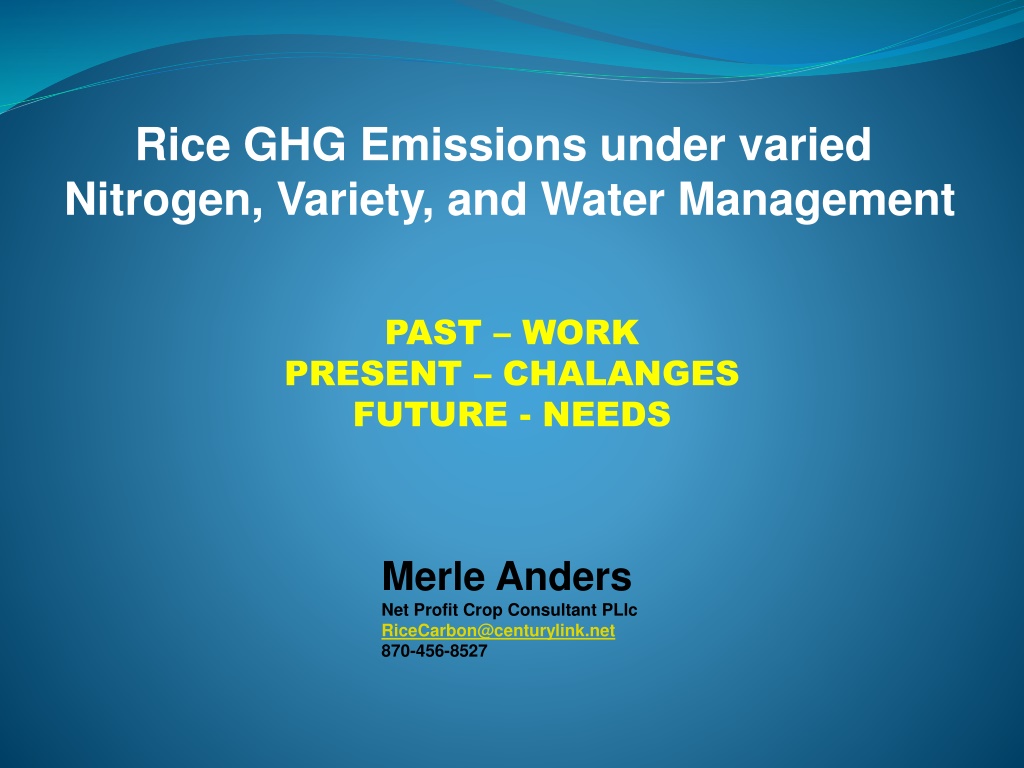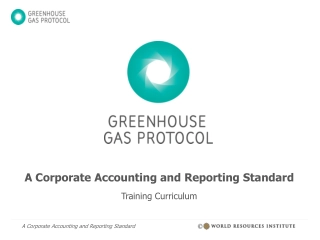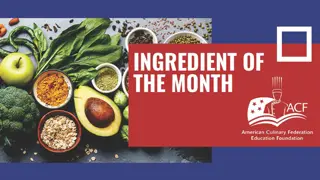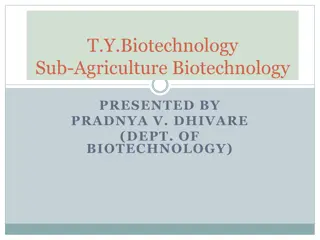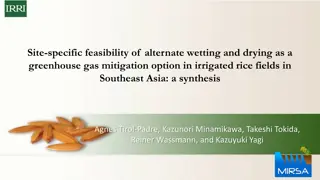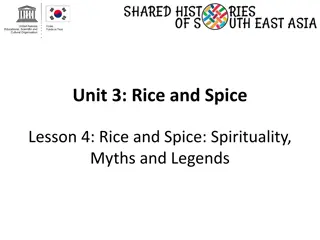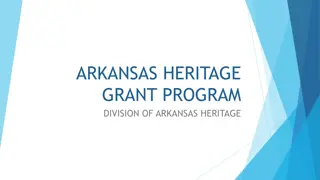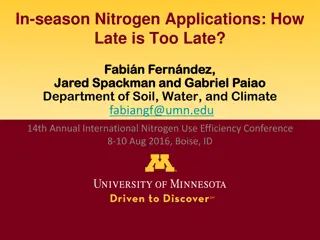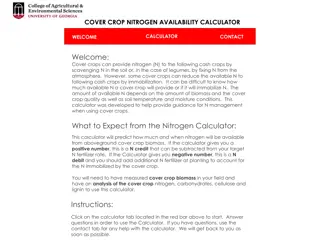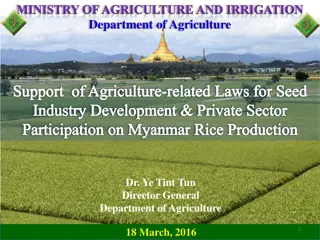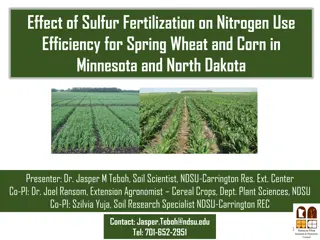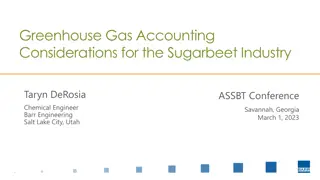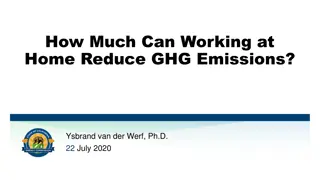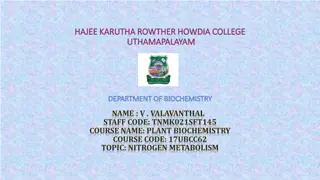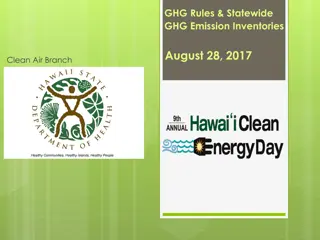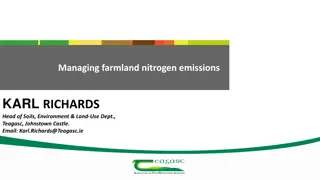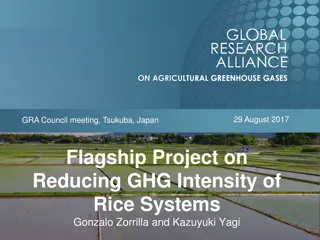Rice GHG Emissions under Varied Nitrogen, Variety, and Water Management Study in Arkansas
Detailed study on rice greenhouse gas emissions under varied nitrogen, variety, and water management treatments, focusing on nitrogen fertility, crop varieties, and water usage impact on methane and nitrous oxide emissions. Research examines optimal nitrogen rates for reduced global warming potential, evaluates CH4 and N2O emissions among rice cultivars, and assesses methane and nitrous oxide emissions from different rice varieties in the southern US. Water study design and data collection details are also provided, including soil characteristics, water treatments, and hybrid varieties tested. Key findings underline the importance of sustainable nitrogen management practices for mitigating greenhouse gas emissions in rice cultivation.
Download Presentation

Please find below an Image/Link to download the presentation.
The content on the website is provided AS IS for your information and personal use only. It may not be sold, licensed, or shared on other websites without obtaining consent from the author. Download presentation by click this link. If you encounter any issues during the download, it is possible that the publisher has removed the file from their server.
E N D
Presentation Transcript
Rice GHG Emissions under varied Nitrogen, Variety, and Water Management PAST WORK PRESENT CHALANGES FUTURE - NEEDS Merle Anders Net Profit Crop Consultant PLlc RiceCarbon@centurylink.net 870-456-8527
PLANTS DON T LIE V. 2.4
Nitrogen fertility CLXL 745 Rates: 0, 112, 168, 224 kg N ha-1 as Urea; single pre-flood % kg CH4- C ha-1 41 a kg CO2 eq ha-1 1375 a 69 bc g N2O-N ha-1 kg CO2 eq ha-1 33 bc Fert. Emis. 0.037 kg N ha-1 112 46 a 1550 a 161 b 76 b 0.080 168 40 a 1336 a 336 a 157 a 0.138 224
Nitrogen fertility N N2 2O emissions O emissions Rice yields Rice yields 50 40 g N2O-N Mg-1 30 20 10 0 -150 -100 -50 0 50 100 150 Yield N surplus (kg N ha-1) 112 kg N ha-1 Adviento-Borbe, M.A., C.M. Pittelkow, M. Anders, C. Van Kessel, J.E. Hill, A.M. McClung, J. Six, and B.A. Linquist. 2013. Optimal fertilizer nitrogen rates and yield-scaled global warming potential in drill seeded rice. J. Evron. Qual., 42:6: 1623-1634.
Variety Total CH4 emissions g CH4-C ha-1 season-1 52874 70411 64499 80980 Total N2O emissions g N2O-N ha-1 season-1 20 0 26 23 Yield-scaled GWP kg CO2 eq Mg-1 season-1 186 287 351 368 GWP kg CO2 eq ha-1 season-1 1775 2351 2166 2715 Rice Variety CLXL 745 Jupiter Sabine Francis Grain Yield Mg ha-1 9.52 8.18 6.17 7.39 Simmonds, M., M. Anders, M.A. Adviento-Bore, C. van Kessel, A. McClung, B. Linquist. 2015. Seasonal methane and nitrous oxide emissions of several rice cultivars in direct- seeded systems. J. Environ. Qual., 44:103-114.
N2O and CH4 emissions from Southern US rice varieties (2012 Drill seeded: Arkansas Site) Variety 50 N2O emission, N2O-N g ha-1 d-1 45 Jupiter Francis CLX 745 Sabine 40 40 Air temperature, oC 35 30 30 25 20 20 15 10 10 5 0 Aug 14 Aug 29 May 01 May 16 May 31 Jun 15 Jun 30 Sep 13 Sep 28 Jul 15 Jul 30 4000 CH4 emission, CH4-C g ha-1 d-1 45 3500 40 Air temperature, oC 3000 35 30 2500 25 2000 20 15 1500 10 1000 5 500 0 Aug 14 Aug 29 May 01 May 16 May 31 Jun 15 Jun 30 Sep 13 Sep 28 Jul 15 Jul 30
Water Study design and data collection Location: Rice Research and Extension Center, Stuttgart AR a. DeWitt Silty Clay Loam soil (fine, smectitic, thermic, Typic Albaqualf) b. pH 5.6-6.2, Carbon 8.4g C kg-1 soil, Nitrogen 0.6 g N kg-1 soil 1. 2. Four replications with 4 water treatments one hybrid (CLXL745) a. Flood, AWD/40-flood, AWD/60, AWD/40 b. AWD = alternate wetting and drying; /value= percent of saturated soil c. AWD/40-flood changed at R1-R2; Dynamax probe used d. Field flooded to 10-cm, natural dry, soil moisture determined when field dry e. Moisture measurements made to 50-mm; 4 plot-1; averaged across reps. f. N rate of 134 kg ha-1 on all treatments as pre-flood (15-20 day hold) g. Irrigation water measured with McCrometer flow meter 3. GHG measurements using 30.48-cm static vented chamber technique a. Collected at 0, 20, 40, 60-min intervals b. Frequency dictated by field management activities and weather
Results for grain yield 2012 ,2013 rice soybean 2013 continuous rice Rice grain yields (Mg ha-1) Water treatment2012-RS 2013-RS 2013-RR Flood 9.78 a Mean 10.26 a 11.15 a 9.84 a 9.27 a 11.15 a 10.33 a 10.17 ab AWD/40 Flood 9.22 a 10.37 b 9.61 a 9.73 b AWD/60 9.03 a 9.58 c 8.31 b 8.97 c AWD/40
Results for water use 2012 ,2013 rice soybean 2013 continuous rice Irrigation water use (m3 ha-1) water use efficiency (WUE = kg rice/m3) 2012-RS Use 7617 (718) 6602 (359) 6475 (180) 5078 (359) 2013-RS Use 7617 (1077) 6475 (538) 5840 (0) 5205 (180) 2013-RR Use Mean Water treatment WUE WUE WUE Use WUE 7939 1.30 Flood 1.28 1.46 8582 1.15 6512 1.58 AWD/40 Flood 1.40 1.72 6459 1.60 5452 1.86 AWD/60 1.42 1.78 4040 2.38 4438 2.12 AWD/40 1.78 1.84 3030 2.74
Results for gas emissions 2012 ,2013 rice soybean 2013 continuous rice CH4 N2O GWP Water management kg CH4-C ha-1 kg N2O-N ha-1 2012 Rice-soybean 0.031 a 0.104 b 0.229 c 0.137 b 2013 Rice-soybean 0.07 b 0.39 a 0.40 a 1.05 a 2013 Rice-rice -0.008 b 0.028 b 0.198 ab 0.329 a kg CO2 eq ha-1 kg CO2 eq Mg-1 249 a 145 b 23 c 14 c 71.0 a 37.2 b 2.8 c 1.7 c 2385 a 1292 b 201 c 120 c Flood AWD/40 flood AWD/60 AWD/40 301 a 181 b 36 c 72 c 100 a 56.7 b 6.04 c 7.80 c 3371 a 2076 b 389 c 751 c Flood AWD/40 flood AWD/60 AWD/40 476 a 235 b 50 c 69 c 144 a 71.4 b 11.8 c 13.7 c 4804 a 2397 b 486 c 611 c Flood AWD/40 flood AWD/60 AWD/40
Results for gas emissions N2O and CH4 emissions in Rice-Soybean rotation under different water management practices (Drill seeded: Arkansas Site 2013) 2013 rice soybean 250 N2O emission, N2O-N g ha-1 d-1 45 200 40 Air temperature, oC 35 150 30 Flooded Intermittent_60 Intermittent_40 Intermittent_40-Flooded 25 100 20 10 50 5 0 0 -5 -10 -50 -15 Apr 01 13 Apr 16 13 Aug 14 13 Aug 29 13 Jun 15 13 Jun 30 13 Jul 15 13 Jul 30 13 Sep 13 13 Sep 28 13 May 01 13 May 16 13 May 31 13 Oct 13 13 Oct 28 13 4500 CH4 emission, CH4-C g ha-1 d-1 45 4000 40 3500 Air temperature, oC 35 3000 30 2500 25 2000 20 10 1500 5 1000 0 500 -5 0 -10 -500 -15 Apr 01 13 Apr 16 13 Aug 14 13 Aug 29 13 Jun 15 13 Jun 30 13 Jul 15 13 Jul 30 13 May 01 13 May 16 13 May 31 13 Sep 13 13 Sep 28 13 Oct 13 13 Oct 28 13
Results for gas emissions 2013 rice soybean 180 Flooded Soil water content CH4 N2O 150 0.4 Soil water content, m3 m-3 -1 day-1 120 0.3 90 kg CO2 eq ha 60 0.2 30 0.1 0 0.0 AWD/60 30 0.4 Soil water content, m3 m-3 -1 day-1 20 0.3 kg CO2 eq ha 0.2 10 0.1 0 0.0 AWD/40 30 0.4 Soil water content, m3 m-3 -1 day-1 20 0.3 kg CO2 eq ha 0.2 10 0.1 0 0.0 Jul 06 Jul 13 Jul 20 Jul 27 Jun 01 Jun 08 Jun 15 Jun 22 Jun 29 Sep 07 May 25 Aug 03 Aug 10 Aug 17 Aug 24 Aug 31 Time
Results 1. Water use efficiency improved 18 to 63% 2. GHG emissions reduced by 48 to 63% 3. Arsenic reduced by 63% 4. GHG emission levels less than reported for corn or wheat 5. Nitrogen efficiency was not reduced 6. Rotation differences in GHG were evident 7. Adoption determined by cost savings and carbon market Linquist, B.A., M. Anders, M.A. Adviento-Bore, R.L. Chaney, L.L. Nalley, E. da Rosa, and C. van Kessel. 2014. Reducing greenhouse gas emissions, water use and grain arsenic levels in rice systems. Global Change Biology, doi: 10.1111/gcb.12701.
Results Farmer adaptation of intermittent flooding using multiple-inlet rice irrigation in Mississippi Joseph H. Massey a, , Tim W. Walker a, Merle M. Anders b, M. Cade Smitha, Luis A. Avila c http://dx.doi.org/10.1016/j.agwat.2014.08.023 0378-3774/Published by Elsevier B.V. The Economic Viability of Alternative Wetting and Drying Irrigation in Arkansas Rice Production Lanier Nalley,* Bruce Lindquist, Kent Kovacs, and Merle Anders Published in Agron. J. 107:1 9 (2015) doi:10.2134/agronj14.0468 Impact of production practices on physicochemical properties of rice grain quality Rolfe J Bryant,a Merle Andersb and Anna McClunga (wileyonlinelibrary.com) DOI 10.1002/jsfa.4608
Results Nitrogen uptake under alternate wetting and drying water management Anders, M.M. et al. Water management impacts rice methylmercury and the soil microbiome Sarah E. Rothenberga,*, Merle Andersb, Nadim J. Ajamic, Joseph F. Petrosinoc, Erika Baloghd Accepted Science of the Total Environment The influence of water management on arsenic uptake in rice grain and aquaporin expression in rice roots Sarah E. Rothenberg a,*, Merle Anders b, Leah B. Schmalfuss a, Erika Balogh c, William J. Jones a, Brian Jackson d Rice grain yield and quality when grown under limited water conditions. Anders, M.M., R.J. Bryant, K.M. Yeater, S. Brooks, and A. M. McClung.
Moving forward? WHAT DO WE KNOW: VERY LITTLE (LESS) GENETICS: 1. Mechanisms of methane production? 2. Improved drought stress and associated traits? NUMBER 1 WILL NEVER RESULT IN INCREASED WATER NUMBER 1 WILL NEVER RESULT IN INCREASED WATER INVENTORY OF GHG EMISSIONS IN MAJOR VARIETIES/HYBRIDS INVENTORY OF GHG EMISSIONS IN MAJOR VARIETIES/HYBRIDS
Moving forward? SCALE RESULTS TO COMMERCIAL FIELDS SCALE RESULTS TO COMMERCIAL FIELDS MANAGEMENT: 1. How dry do we need to be? 2. When do we need to be drier or wetter? 3. How do we measure soil moisture for management? 4. GHG emission levels in row rice? 5. Added N2O measurements to field scale measurements? 6. Include other disciplines such as microbiologists? RCPP, Climate Change Initiative, NRCS changes http://www.sustainablerice.org/
